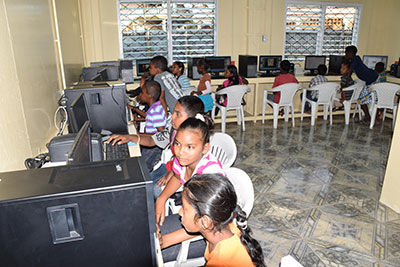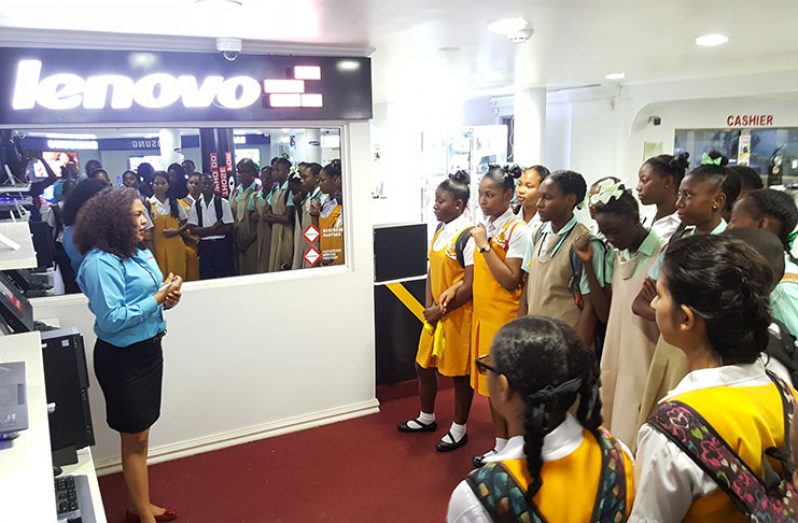– driven by an innovative public/private partnership to reach all Guyanese
By Ravena Gildharie
FROM Matarkai in the North West District to Aishalton in the South Rupununi, Guyana is currently a hive of Information and Communication Technology (ICT) transformation, led by a revolutionary partnership between the public and private sectors.

While the state’s National Data Management Authority (NDMA) is reeling out a series of community-based initiatives that are enabling thousands of citizens across the coast and hinterland to connect with the most advanced technologies of this internet era, businesses such as the Guyana Telephone and Telegraph Company (GTT), Digicel Guyana and Starr Computers are pursuing other innovative ICT expansions.
It has been five months since the National Data Management Authority (NDMA) was merged with the eGovernment Agency to create one entity with combined resources to accelerate the national ICT agenda. With a $1.7 billion 2017 allocation, the agency enlisted the private sector to boost its ICT work programme.
ICT in education
The agency recently completed phase one of its Secondary Schools Internet Connectivity Project, through which over 100 coastal secondary schools and other technical institutions were provided with well-equipped, internet-ready computer laboratories. The initiative then shifted to the hinterland with internet already installed at secondary schools in Port Kaituma, Mabaruma, Bartica, Waramadong, Mahdia, Paramakatoi, Kwakwani, Annai, St. Ignatius and Sand Creek, among others. Installation is ongoing in areas such as Santa Rosa, Matthew’s Ridge, Linden, Aishalton and Masakenari.

During an exclusive interview with the Pepperpot Magazine, NDMA’s Chief Executive Officer Floyd Levi, said the coastal schools are connected via the E-governance network, while the hinterland is served by a satellite-based system, being installed along with a local private company.
Levi acknowledged that the satellite connection is very expensive, costing about $600, 000 per month at each hinterland site, but the benefits are overarching.
“Students who are doing CSEC require the internet, as it is actually mandatory for students to prepare their SBAs. So those students who have access to the internet have a clear advantage over those who don’t have, and we are trying to bridge that gap that exists between those schools in the hinterland and those in the coast,” Levi said. The project complements The One Laptop Per Teacher (OLPT) Initiative, which seeks to better equip educators in the public system to deliver the curriculum, using modern technology.
ICT in far outlying communities
The NDMA is maximising the school’s hinterland investment, by integrating essential government services such as health, public security and local government. Levi noted that this is a major aspect of Guyana’s ICT drive, to boost the provision of government services, again using advanced technology. Efforts are ongoing to digitise services such as birth registrations, applications for birth certificates, passports and other necessary documents.

“The citizenship requirements or civil events of registering a birth, getting a birth certificate, those are some our priority projects that we would like to provide over the eGovernment network so citizens do not have to leave their communities to get that done. All of that could be done online through our e-governance system,” Levi highlighted.
The agency is partnering with the Guyana Post Office Corporation (GPOC) at post offices countrywide to support the e-Governance network.
“We see the post office as an integral role in this transformation of government services…if you want to buy something online, you can order it and have it shipped to the Guyana Post Office Corporation and they would in turn deliver that to your community, if you are in the hinterland,” Levi explained.
Added to these services, the NDMA has also installed several ICT Hubs, which enable community members to access computers and internet services as part of its Improving Digital Equity Access and Learning (IDEAL). The project, which began last year, has since seen 39 Community ICT Hubs established in Regions Two, Three, Four, Five and Six, with more than 100 additional hubs planned for various parts of the country, including the hinterland.
The agency also conducts high-level training of its staff and ICT personnel in the public service. The Centre for Excellence in Information Technology (ICT) at the University of Guyana is almost completed and will soon deliver high-end courses through scheduled classes, ideally designed for local personnel.
Additionally, there is a pilot project involving the state’s emergency response units, particularly the fire and emergency medical services.
“We are working with the Fire Service on an emergency response system, where persons will call in and state their emergency, whether fire or medical, and a particular vehicle would be dispatched using GIS (Geographic Information System) and other updated technology,” Levi revealed. The project is intended to help local ICT personnel better understand the operations and requirements of a larger-scale service.
Public/private partnership to drive ICT
Noting the current ICT hype, the NDMA’s CEO alluded to the public/private partnership as the driving force to accelerate Guyana’s technological advancements with the state utilising existing services and infrastructure of private companies.
“We purchase internet from GTT. We are actually the largest single purchaser of internet from GTT. We are also doing our expansion in the hinterland using services of Digicel to expand the network to Region One communities, Kwakwani, Mahdia, Linden and Bartica among others,” Levi stated. The agency also uses private software developers to help create applications, whether web-based or client-service type.
“There are good opportunities for the private sector, especially those companies already involved in ICT. We put out advertisements in the newspapers regularly for private companies to bid for projects and services,” Levi advised.
Private sector initiatives
The private sector has also been forging its own ICT agenda with various innovative ICT projects and services that support the country’s technological advancement. Just two weeks ago, telecoms giant, GTT, launched its massive $5 billion ‘Blaze’ high-speed internet that caters for some 20, 000 households at affordable rates. This is the company’s official launch of its mega fibre optic cable service into the homes of Guyanese, a project that has been years in the making.
“Even outside of the larger cities in the U.S., you don’t get this type of fibre optic service, so this is revolutionary for Guyana. This is really what we are about at GTT, we have already started a number of partnerships and we are going to partner with young people that have ideas to drive Guyana forward. We are building the service throughout Guyana at places that already have phone lines and also at those places that are now developing,” GTT’s CEO Justin Nedd stated at the ‘Blaze’ launch.
The company previously unveiled its 4G LTE Internet service to customers, including those on the Essequibo Coast.
On the services side, GTT is expanding its Mobile Money application, allowing Guyanese to pay basic utility and other bills from the comfort of their mobile smart devices. Just recently, the University of Guyana was added to the system, enabling students to pay their dormitory, application, general and graduation fees. The Guyana Power and Light (GPL) Company, COURTS, Singers and the Institute of Private Enterprise Development (IPED) are some providers already connected to the MMG. Users can also transfer money and shop with the application.
Meanwhile, GTT is still partnering with private firm, General Datatech, L.P.–GDT, to improve the Broadband Core and Access Network. The system upgrade, coupled with GTT’s substantial undersea capacity, will facilitate a substantial improvement in broadband and data connectivity services through provision of faster speeds and a more secure and reliable connection. The project for upgrading the network is expected to be completed by the third quarter of 2017.
Starr Computers, a private business on Brickdam in Georgetown, is another company leading ICT growth with significant investments in research and development of modern technology, both in terms of services/applications and equipment/devices. The company introduces these to Guyanese through educational and informative seminars held at least twice per month and offered free of cost. Each session accommodates between 30-40 participants including students from secondary schools, university, technical and vocational institutes and others.
“While we send our staff to various countries to learn about new technology, we’ve also been bringing professionals from some of the leading global companies such as Samsung, Lenovo, APC, HP and more recently Honeywell…We have them at these workshops and training to expose students not only to current technology, but to give them an insight of ICT beyond 2018,” Starr’s Managing-Director Rehman Majeed told the Pepperpot Magazine.
Despite Guyana’s limited ICT infrastructure, he noted positive signs with the expansion of high-speed internet such as GTT’s fibre optic service, disruptive innovations such as Uber, Amazon and Netflix and the growing Business Processing Outsourcing (BPO) network.
“Looking ahead, there are numerous opportunities. With call centres for instance, the BPO network can provide employment for about 25,000 persons. We probably now have about 8, 000 employed, but again it all comes back to us [to] have fast, reliable and efficient internet,” Majeed indicated.
With technology advancing daily, the businessman said his company is committed to keep Guyanese updated and strives to make products affordable, even by partnering with local financial institutions and GTT.



.jpg)








